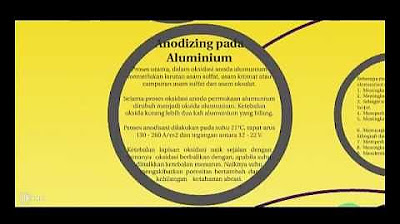Anodisasi
Summary
TLDRThis video discusses the anodization process in surface coating, particularly focusing on its use in hard anodizing techniques. It defines anodization as a method of creating an oxide layer on metal surfaces, primarily aluminum, to enhance corrosion resistance, adhesion, and appearance. The process involves electrolytic reactions, creating durable, shiny coatings. Two key types are soft and hard anodizing, with differences in temperature and current used. The video also covers preparation methods, ionization mechanisms, and how parameters like temperature and current impact coating quality and hardness.
Takeaways
- 🔧 Anodizing is a coating technique used to create an oxide layer on the surface of workpieces through an electrolysis process, primarily used on aluminum.
- ⚙️ The purpose of anodizing includes improving corrosion resistance, enhancing adhesion, and providing a more decorative and shiny surface finish.
- 🔍 There are two types of anodizing processes: regular anodizing, done at room temperature with low current, and hard anodizing, which focuses on abrasion resistance and higher hardness, done at lower temperatures with higher current.
- 🧪 Anodizing can involve multiple materials such as aluminum, copper, silver, tantalum, and calcium, but aluminum is the most common.
- 🎨 The process can also involve coloring to improve the decorative appearance of the metal, often resulting in a brighter, polished look.
- 🧱 The anodizing process includes barrier layer formation, pore creation, and the development of a porous oxide structure, which helps in adhesion and durability.
- 🔄 The electrochemical process involves the migration of ions, resulting in reactions at the anode that produce the anodized oxide layer.
- ⚡ The current and potential applied during anodizing affect the thickness and properties of the oxide layer. Higher currents can produce thicker layers but may risk burning the surface.
- 📏 The size of pores and thickness of the oxide layer is influenced by several factors such as temperature, electrolyte concentration, and ionization potential.
- 🔨 Hard anodizing is more resistant to wear and abrasion, with smaller pore sizes and higher hardness, making it suitable for more demanding applications.
Q & A
What is anodization as discussed in the transcript?
-Anodization is a surface coating technique performed using electrolysis. It forms an oxide layer on the surface of a workpiece, typically aluminum, to improve properties such as corrosion resistance and adhesion.
What are the primary materials used for anodization?
-The most common material used in anodization is aluminum, but other metals like titanium, tantalum, calcium, copper, cadmium, and silver can also be used.
What are the main objectives of anodization?
-The objectives include improving corrosion resistance, increasing adhesion of coatings, enhancing decorative appearance, and improving abrasion resistance.
What are the two types of anodization mentioned?
-The two types of anodization mentioned are regular anodization and hard anodization. Regular anodization occurs at room temperature with lower current, while hard anodization uses higher current and is designed for improved hardness and abrasion resistance.
What is the purpose of hard anodization?
-Hard anodization aims to increase the hardness and wear resistance of the surface, often applied to metals that require stronger, more durable coatings.
What is the role of surface treatment before anodization?
-Surface treatment before anodization improves the adhesion of the subsequent coating layers. It ensures the surface is clean and ready for the anodization process, which results in better quality and adhesion.
What is the function of the electrolyte in the anodization process?
-The electrolyte facilitates the electrolysis process during anodization, where ions migrate toward the anode and cathode, leading to the formation of an oxide layer on the metal's surface.
What happens at the anode and cathode during anodization?
-At the anode, oxidation occurs, forming an aluminum oxide (Al2O3) layer. At the cathode, hydrogen gas is produced as a byproduct of the reaction.
What are the factors that influence the quality of the anodized layer?
-Factors include the potential (voltage), temperature of the electrolyte, current density, electrolyte concentration, anodization time, and pH level, all of which affect the thickness, porosity, and appearance of the oxide layer.
What is the significance of coloring in anodization?
-Coloring enhances the decorative appearance of anodized surfaces. The process involves either organic or inorganic dyes, and sometimes a combination of dyeing and electrolytic coloring, to achieve a desired color and finish.
Outlines

此内容仅限付费用户访问。 请升级后访问。
立即升级Mindmap

此内容仅限付费用户访问。 请升级后访问。
立即升级Keywords

此内容仅限付费用户访问。 请升级后访问。
立即升级Highlights

此内容仅限付费用户访问。 请升级后访问。
立即升级Transcripts

此内容仅限付费用户访问。 请升级后访问。
立即升级浏览更多相关视频

ANODIZING PROCESS - Proses Pelapisan Teknik Anodising

Introduction to Surface Treatment

Copper and Nickel Plating | Elektroplating tembaga dan Nikel Lengkap

Mastering Hard Surface Modeling in Blender Essential Tips for Beginners

It looks funny, but it's seriously GRATE! Nabalis Cheese Balisong Review

#234 ANODIZZARE ALLUMINIO COLORATO FAI DA TE - How to ANODIZE and COLOR ALUMINIUM DIY [SUB ENG]
5.0 / 5 (0 votes)
